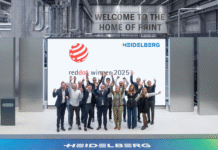For a long time, digital Printing was considered a solution for print-on-demand only and most people (myself included, I must admit) were skeptical about its being a serious contender for package printing, a segment that is driven by high speeds (e.g. 1000 meters/minute for any high-end gravure press), high rates of output and the wider widths that are necessary to achieve this.
There are several trends that have contributed to the emergence of digital printing, especially in the label and narrow web segments. These are:
– A distinct improvement in print reproduction and achievement of near offset quality.
– Substantial reduction in costs per impression.
– Very high levels of machine utilisation (almost no down-time for set-up, change-overs and ink changes).
– Ability to print on a variety of substrates and basis weights (grammages) without too many adjustments.
– Low start-up costs – no plates/cylinders, no set-up waste.
– Drastic reductions in run length per print job accompanied by frequent design changes.
– Customer demands for quick turnaround and speed to market.
– Customisation and the need to print variable data (for promotional activities, personalisation, security applications, barcodes, numbering) and to accommodate micro-segmentation of markets.
– Development of the HP Indichrome Plus system, a seven-colour Pantone simulation using CMYK plus orange, violet and green that provides a gamut of over 95 per cent of all Pantone shades; this gives better reproduction of multi-colour designs and enables transfer of jobs from conventional print processes to digital printing without affecting print quality.
– Today, a single colour device can deliver cost-effective black & white printing and upto 7 colour printing with exact colour matches and the smallest particle size available.
The most telling statistic is that, in 2006, the largest narrow web press supplier to the label segment was HP Indigo (they accounted for 82 per cent of digital presses sold), who leap-frogged Gallus, Mark Andy and Nilpeter in the process. While this had been forecast to take place during 2008, it has actually happened two years earlier.
Overall printing trends also favour a marked shift to digital colour processes. InfoTrends, the well-known specialists in market research for the printing industry, have highlighted how black & white and spot colour pages are moving to colour, transactional pages are becoming more graphically oriented/colour rich and job runs are rapidly going down. All this means that the highest growth area for print service providers is in digital colour.
In 2005, only 6 per cent of the total 48.1 trillion pages printed worldwide were digitally printed. However, the digital segment is projected to grow @ 17 per cent per annum between 2005 and 2010 as against 3 per cent for the analog segment. In the label segment, digital printing is slated to grow @ 32 per cent per annum as compared to 6 per cent for analog processes.
In an independent survey on package printing, PIRA International has estimated that from 2005 to 2015, digital printing will account for about 30 per cent of all printing worldwide at the retail level and the number of printing presses using offset, flexography and gravure will drop by 42 per cent. Packaging and labels will see huge growth and, while 75 million square feet of labels are currently printed on litho and flexo presses, 50 per cent of this volume will be printed digitally by 2015. In India, one of the two largest growing markets, the growth in digital printing between 2000 and 2005 is 559 per cent and that between 2005 and 2010 will be 64.6 per cent, the highest of any print process.
To demonstrate the flexibility and suitability of digital printing for label production, an interesting exercise was carried out at Flexible Technologies, Utah, USA on the 17th of August 2006. Using just a single HP Indigo ws4050 digital press, they started printing at 8:00 a.m. and ran it continuously for a full 8-hour shift. During this period, they printed 23 different label jobs totalling over 200,000 labels; the individual print runs ranged from 2,000 labels to 50,000 labels. Over the entire shift, there were only 11 minutes of down-time and even these were due to roll changes and press maintenance. This is not a one-off achievement as this converter typically prints about 100 label jobs a day between two HP Indigo digital presses.
At what stage do traditional print processes start becoming cheaper than digital printing? This largely depends on the kind of job and on converter-specific costs. According to HP Indigo, they have found that this break-even happens at print runs of around 2,000 running meters. Print runs shorter than this figure will probably find digital printing the cheapest option.
There is another very interesting potential usage area for digital presses that I predict will become a niche segment. One of the bottlenecks today in analog print processes like litho, gravure and flexography while designing a package, proofing it and making changes to the design on the fly is that the correct representation of the output can only be obtained after the plates/cylinders have been prepared and put through a time-consuming proofing process on an expensive proofing press. Substantial cost has already been incurred and any major adjustments required mean writing off these costs and starting afresh from scratch. An ideal way out is to use a digital press for the designing/adjustment/ proofing process and to then transfer the design parameters to any other printing process. All it requires is really the ability to transfer the parameters and workflow to the other process, something which can be mastered with a little bit of experience and without too much of difficulty. In fact, some mainstream printers and converters who primarily use the other conventional analog printing processes have already started using this as a design and proofing tool. Another big advantage is that the design, adjustment and approval process can involve any number of people at different locations through a digital network and the final results can be immediately visualised in real time at each stage. The press itself can also be used to supplement production, whenever necessary.
We can look forward to an exciting phase in the development of digital printing as an eminently viable package printing option. And, if the digital press makers can work on increasing print speeds by even a little bit, the transition from traditional technologies to digital printing can be even more rapid.










